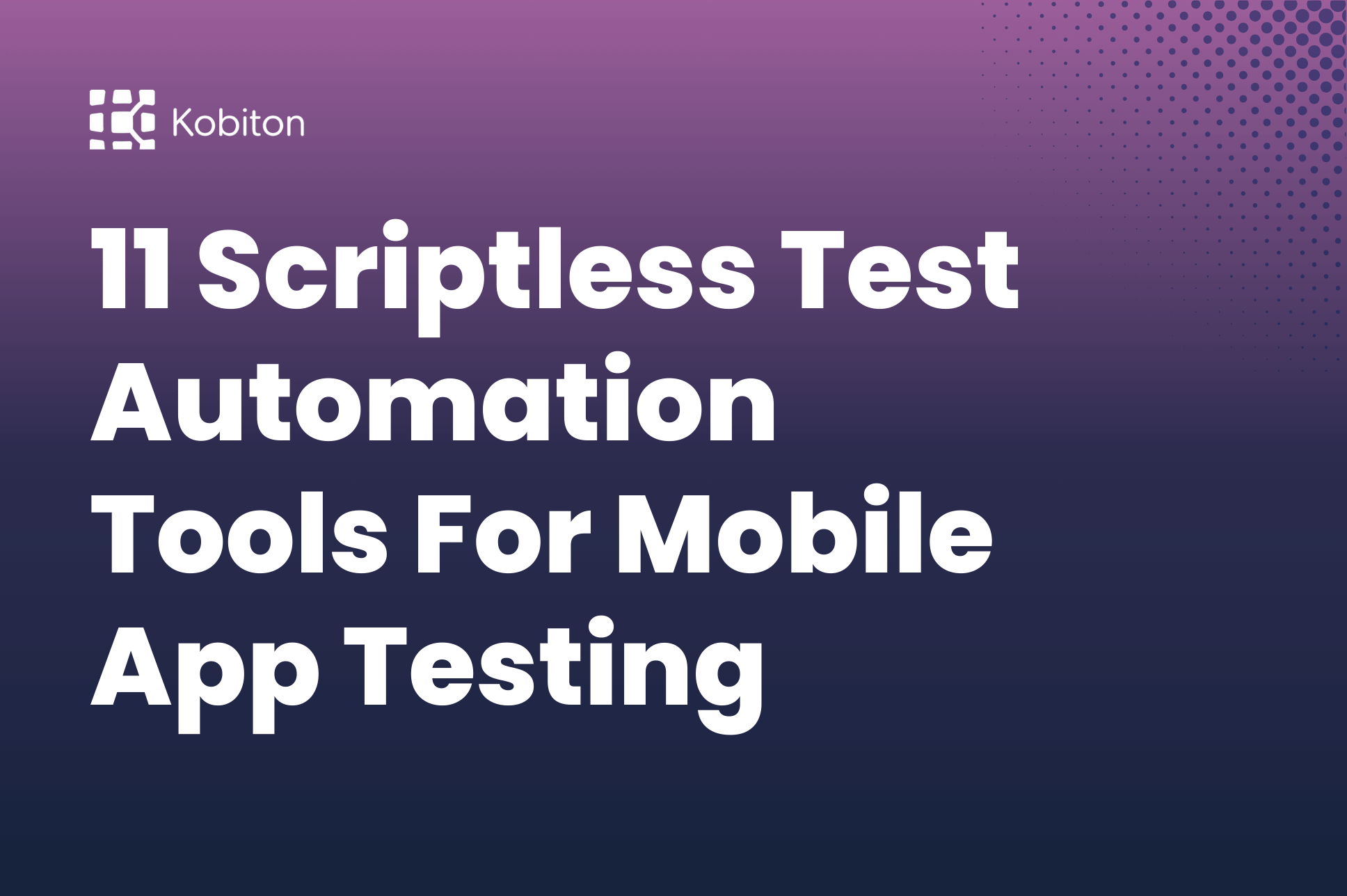
11 Scriptless Test Automation Tools For Mobile Application Testing

Adam Creamer
In the rapidly evolving landscape of mobile application development, ensuring flawless app performance across an array of devices has never been more critical—or more challenging. Traditional testing methods such as manual testing, scripted automation, and isolated functional tests have been the backbone of quality assurance. However, these approaches often struggle to keep pace with the accelerating speed of mobile app releases and the increasing complexity introduced by diverse operating systems and device fragmentation.
Manual testing, while thorough, is time-consuming and scales poorly, limiting its feasibility in a fast-paced development cycle. Scripted automation offers speed but requires significant upfront development and ongoing maintenance as app interfaces and functionalities evolve. Isolated functional tests, on the other hand, can miss critical integration issues or device-specific anomalies, compromising the user experience.
Today’s developers and testers are under immense pressure not only to achieve perfection in user experience but also to accelerate market delivery and streamline development processes. This is where AI-augmented mobile app testing comes into play. It represents a dynamic solution that promises to surpass the limitations of traditional methods by integrating advanced artificial intelligence to automate and optimize testing tasks.
Our recent webinar in conjunction with Applitools, featured insights from industry experts like Kobiton CTO, Frank Moyer and Applitools Senior Sales Engineer, Martin Kowalewski, sheds light on revolutionary AI-powered solutions that promise to redefine mobile app testing.
The Applitools webinar, led by industry veterans Frank Moyer and Martin Kowalewski, delved deep into the evolving landscape of mobile application testing. Throughout the discussion, the focus remained sharply on bridging the gap between manual testing practices and the cutting-edge realm of automated solutions, crucial for modern application development. Frank Moyer emphasized the pressing need for this transition with a compelling call to action:
“…how do we get manual testers to automation as fast as possible?…
Organizations are increasingly moving towards automation in testing for several compelling reasons:
Efficiency and Speed: Manual testing is time-consuming and often becomes a bottleneck in the software development lifecycle, especially with the need for rapid releases in today’s agile environments. Automation significantly reduces the time required for testing by executing multiple tests simultaneously and quickly.
Consistency and Accuracy: Human testers are prone to error, particularly when carrying out repetitive and detailed tasks. Automated tests perform the same steps precisely every time they are executed, eliminating the chance for human error and ensuring consistency in test results.
Cost Effectiveness: Although the initial setup for automated testing can be resource-intensive, it saves considerable amounts of time and labor in the long run. As tests need to be repeated often throughout the software development cycle, automation reduces the cumulative cost of the repeated manual testing efforts.
Scalability: Manual testing methods do not scale well with the increasing complexity and scope of applications, especially when apps need to function across various devices and platforms. Automated testing easily scales to cover this breadth, providing thorough coverage across numerous scenarios that would be impractical to test manually.
Despite the advantages, the shift from manual to automated testing presents challenges:
Skill Gaps: There is often a requirement for new skills, as team members need to understand and develop automated test scripts and manage automated testing tools. Intuitive testing platforms like Kobiton make learning easy and shrink skill gaps.
Initial Investment: Setting up automated testing requires an upfront investment in tools and training. Kobiton’s transparent pricing reduces sticker shock and makes it easier to scale automated testing.
Maintenance of Test Scripts: Automated tests can be brittle and may require regular updates to keep pace with changes in the application’s user interface or functionality. Kobiton’s AI-augmented capabilities include self-healing. It intelligently identifies when a script fails to locate a specified identifier and seamlessly shifts to the next best match, ensuring tests proceed without interruption.
By adopting automated testing, organizations can enhance their operational efficiency and the effectiveness of their testing protocols, leading to:
Martin Kowalewski highlighted how Applitools leverages visual AI and autonomous testing platforms to enhance the capabilities of automated testing further:
Applitools’ Visual AI simulates human eyes and brain to see and interpret applications’ screens precisely. It can detect visual anomalies that traditional automated tests might miss, such as slight changes in layout, color, or text, which could affect user experience. Visual AI thus brings an additional layer of accuracy and robustness to automated testing.
These platforms are designed to operate independently of human input, making decisions about what tests to run and when, based on code changes and other criteria. This not only increases the efficiency of the testing process but also ensures that testing evolves in step with the application without requiring constant human oversight.
Kowalewski elaborates on the transformative impact of these technologies:
“…by infusing AI at each step of the testing lifecycle, we not only streamline processes but also create a dynamic system that adapts to changes and continuously improves its testing effectiveness without additional human intervention.”
This approach represents a significant evolution from traditional testing methods, positioning Applitools at the forefront of the shift towards more intelligent, responsive, and efficient testing solutions.
Benefits of AI-Augmented Testing Tools
AI technologies integrated into testing tools can perform a variety of functions that traditionally required manual intervention. These tools can automate repetitive tasks, such as filling out forms, clicking buttons, and navigating through menus, which are time-consuming when done manually. Moreover, AI can simulate complex user interactions that involve gestures like swiping, pinching, and zooming, which are crucial for mobile applications. This capability allows developers to create and run tests that mimic real user behaviors more accurately and comprehensively.
Martin Kowalewski highlighted the impact of these advancements during the webinar, noting the substantial increase in efficiency and accuracy that AI brings to the testing process:
“…enables teams to reduce test creation and ongoing maintenance time by up to 80%. This not only speeds up the development cycle but also significantly lowers the costs associated with prolonged testing phases.”
This statement underscores the drastic improvements in productivity and resource allocation that AI-augmented tools offer, allowing teams to focus more on innovation and less on the mechanics of testing.

One of the most challenging aspects of mobile app testing is ensuring that applications perform consistently across a wide range of devices and operating systems. Device fragmentation is a major issue, with new devices constantly entering the market, each with different screen sizes, resolutions, operating systems, and hardware capabilities.
Frank Moyer discussed how Applitools addresses this challenge through visual AI:
“Every company is now a software company, and as companies have gone digital, they are all seeing an explosion in the number of applications they build, the complexity of these applications, the frequency of releases, and the number of screens and devices these are used on… Visual AI helps ensure that no visual defects slip through the cracks, regardless of the device or operating system.”
By using visual AI, Applitools provides a solution that can automatically detect and report discrepancies that might not be caught by traditional testing methods. This technology is particularly effective in identifying visual defects that could affect the user experience but might be missed by standard automated tests.
Frank Moyer elaborated on the importance of visual consistency in mobile apps:
“…if there is a visual defect that impacts even a small percentage of our mobile market on just one device, it could cost significantly. Visual AI ensures that our applications look and function as intended on every device, preventing potential revenue loss and damage to our brand reputation.”
This approach highlights how critical it is for businesses to maintain a uniform appearance and functionality across all platforms, ensuring that all users have a high-quality experience, which in turn fosters user loyalty and trust in the brand.
The integration of AI into mobile app testing, as vividly discussed in the Applitools webinar, heralds a transformative era for developers and testers alike. By automating repetitive tasks and simulating complex user behaviors, AI-augmented tools like those offered by Applitools are setting new standards in testing efficiency and accuracy. These advancements not only alleviate the manual burden traditionally associated with quality assurance but also ensure that applications can meet the high expectations of today’s tech-savvy users across various devices and platforms.
As organizations strive to stay competitive in a rapidly evolving digital landscape, the ability to deploy high-quality apps quickly and efficiently becomes crucial. AI-integrated testing tools are key to achieving this, enabling faster deployment cycles and reducing the likelihood of costly post-release fixes. In essence, these tools don’t just streamline testing processes—they enhance the overall quality of the digital products we rely on every day.
To gain a deeper understanding of how AI can revolutionize your mobile app testing strategy, we invite you to view the full Applitools webinar. Here, you’ll find detailed discussions and insights that can help you make informed decisions about integrating these advanced technologies into your workflow. Additionally, we encourage you to explore Applitools’ range of solutions further to discover how they can assist in enhancing your development cycles and ensuring that your applications not only function flawlessly but also deliver exceptional user experiences.
Are you ready to see how AI can impact mobile testing?
Sign Up For Your Free Trial Today.
No Credit Card. No Commitment.
Try Kobiton today with a free trial and get: